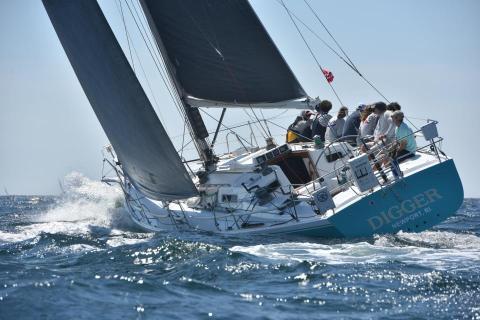Double Handed Knockdown
“From the CCA School of Hard Rocks
...lessons learned in pursuit of the Art of Seamanship”
By James Phyfe, Boston Station
After several years of struggling to find sufficient crew for overnight races on our J/44, I decided to do a few things last winter to make the boat easier to race double-handed. In addition to modifying the racing headsails to fit on the furler, I added a luff line to the mainsail and replaced the autopilot. The first test of the new configuration was to be the 186-mile Block Island Race, which is run annually by the Storm Trysail Club from Stamford, CT, around Block Island and back. Starting the Friday of Memorial Day Weekend, this event is well known for breezy conditions, with cold water and lots of wind shear. Indeed, during the first 18 hours of the race, we had seen fast reaching, a stormy midnight beat down the east coast of Block Island and several patches of light-air drifting. This being more of a “sprint” than a “marathon,” neither I, nor my co-skipper, Todd, slept more than an hour or so.
By mid-afternoon Saturday, we were not more than 10 miles from Stamford Harbor in light winds, reaching in 5-8 knots under A1 and full mainsail. As we worked to keep the boat moving and keep track of the fleet consolidating near the finish, we noticed a band of dark clouds approaching over Long Island. This was not unexpected, as we knew a front would bring clearing weather and Easterlies the next day. As the front approached, it became clear that several boats in front of us were struggling to get sail in, and we decided we ought to do the same ourselves. Springing into action, we raised the genoa (the Number 1 was ready on the foredeck, having been dropped despite the roller furling) and moved to douse the spinnaker. No sooner had we attempted to trip the tack line (which failed) than we were hit with a 65-knot gust (as measured by a nearby still-upright competitor) and driving rain. The boat went immediately over on its side, as the autopilot tried in vain to stay on course. At the time, I was caught outside the lifelines standing on the bowsprit trying to manually release the tack, and Todd was struggling in the cockpit to release sheets and disengage the autopilot. When I did finally release the tack, the sail, by that time in ribbons, was streaming far behind the boat with much more force than we could possibly overcome to bring it back aboard. Knowing we had no alternative, we released the halyard, which ran out through the masthead and allowed the sail to rest on the water. By the time we dragged it and 150-feet of halyard back aboard, the squall was beginning to pass and we were able to slowly bring the boat back up and regain way. Although bruised and embarrassed, we were thankful to have escaped worse damage.
What we learned:
- We were complacent, at least partially because of fatigue and exacerbated by our proximity to the finish. It took us a few minutes to recognize the danger and begin to shorten sail. When we did, we followed our racing routine, which meant raising the genoa before dropping the spinnaker. In hindsight, the priority at that point was to get the spinnaker down. The few seconds we may have lost running bareheaded were immaterial compared to the minutes we lost trying to get the spinnaker out of the water and the boat back on her feet afterward.
- We were complacent. The J/44 has opening portholes in the aft side of the cabin house, which we keep open during day races to throw halyard tails down. When the squall hit, we were knocked down instantly with all the spreaders in the water. While I struggled on the bowsprit, Todd looked down in the cockpit to see water lapping up against the edge of the open portholes. In any kind of seaway, water would have rushed down, and the consequences could have been much worse.
- We were complacent. Because this was the first time we had raced doublehanded on this boat, there were a lot of scenarios we did not plan for. In this case, we should have known the autopilot would struggle to bring the boat back into the wind and on course, exacerbating (if not causing) the knock-down. Once it is clear we would not beat the squall, we should have immediately switched off the A/P and headed downwind. Sure, we might have blown out the spinnaker, but that happened anyway.
The Cruising Club of America is a collection of passionate, seriously accomplished, ocean sailors making adventurous use of the seas. All members have extensive offshore boat handling, seamanship, and command experience honed over many years. “School of Hard Rocks” stories, published by the CCA Safety and Seamanship Committee, are intended to advance seamanship and help skippers promote a Culture of Safety aboard their vessels






